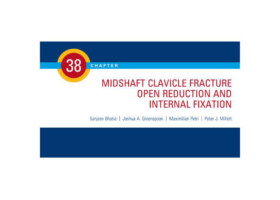
Authors:
Sanjeev Bhatia, Joshua A. Greenspoon, Maximilian Petri, Peter J. Millett
Abstract:
Clavicle fractures are extremely common and comprise 2.6% to 5% of all fractures in adults, with midshaft injuries accounting for almost 75% of all fracture types. Clavicle fractures typically occur when an axial load is applied to the bone, usually in the form of a sudden point load to the apex of the shoulder. When these fractures displace, the proximal fragment generally is pulled superiorly by the sternocleidomastoid muscle while the distal fragment is pulled laterally by the weight of the arm.
Most nondisplaced or minimally displaced clavicular fractures can be managed nonsurgically simply by placing the arm in a sling. In these instances, the nonunion and malunion rates are extremely low. However, when midshaft clavicular fractures present with complete displacement or signi cant shortening, the risk of nonunion is significantly higher with conservative management. The surgical decision making remains a matter of debate. At present, the only absolute indications for surgical treatment of clavicular fractures include open injuries and fractures associated with evolving skin compromise. Relative indications for open reduction and internal fixation of midshaft clavicular fractures include injuries with 15 to 20 mm of shortening, completely displaced fractures, fractures with significant comminution, oating shoulder injuries that involve a concomitant glenoid neck fracture, painful nonunions, and midshaft clavicular fractures in certain multisystem trauma cases.
For the complete study: Midshaft Clavicle Fracture Open Reduction and Internal Fixation
